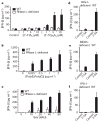Small self-RNA generated by RNase L amplifies antiviral innate immunity
- PMID: 17653195
- PMCID: PMC3638316
- DOI: 10.1038/nature06042
Small self-RNA generated by RNase L amplifies antiviral innate immunity
Abstract
Antiviral innate immunity is initiated in response to RNA molecules that are produced in virus-infected cells. These RNAs activate signalling cascades that activate the genes that encode alpha- and beta-interferon (IFN). Signalling occurs through the interaction of the RNAs with either of two pathogen recognition receptors, retinoic acid-inducible gene-I (RIG-I, also known as DDX58) and melanoma differentiation associated gene-5 (MDA5, also known as IFIH1), which contain amino-terminal caspase activation and recruitment domains (CARD) and carboxy-terminal DExD/H Box RNA helicase motifs. RIG-I and MDA5 interact with another CARD protein, interferon-beta promotor stimulator protein-1 (IPS-1, also known as MAVS, VISA and Cardif), in the mitochondrial membrane, which relays the signal through the transcription factors interferon regulatory factor 3 (IRF-3) and nuclear factor (NF)-kappaB to the IFN-beta gene. Although the signalling pathway is well understood, the origin of the RNA molecules that initiate these processes is not. Here we show that activation of the antiviral endoribonuclease, RNase L, by 2',5'-linked oligoadenylate (2-5A) produces small RNA cleavage products from self-RNA that initiate IFN production. Accordingly, mouse embryonic fibroblasts lacking RNase L were resistant to the induction of IFN-beta expression in response to 2-5A, dsRNA or viral infection. Single-stranded regions of RNA are cleaved 3' of UpUp and UpAp sequences by RNase L during viral infections, resulting in small, often duplex, RNAs. We show that small self-RNAs produced by the action of RNase L on cellular RNA induce IFN-beta expression and that the signalling involves RIG-I, MDA5 and IPS-1. Mice lacking RNase L produce significantly less IFN-beta during viral infections than infected wild-type mice. Furthermore, activation of RNase L with 2-5A in vivo induced the expression of IFN-beta in wild-type but not RNase L-deficient mice. Our results indicate that RNase L has an essential role in the innate antiviral immune response that relieves the requirement for direct sensing of non-self RNA.
Conflict of interest statement
The authors declare no competing financial interests.
Figures




References
-
- Saito T, Gale M., Jr Principles of intracellular viral recognition. Curr Opin Immunol. 2007;19:17–23. - PubMed
-
- Yoneyama M, et al. The RNA helicase RIG-I has an essential function in double-stranded RNA-induced innate antiviral responses. Nature Immunol. 2004;5:730–737. - PubMed
-
- Kato H, et al. Cell type-specific involvement of RIG-I in antiviral response. Immunity. 2005;23:19–28. - PubMed
-
- Kato H, et al. Differential roles of MDA5 and RIG-I helicases in the recognition of RNA viruses. Nature. 2006;441:101–105. - PubMed
Publication types
MeSH terms
Substances
Grants and funding
LinkOut - more resources
Full Text Sources
Other Literature Sources
Molecular Biology Databases
Research Materials
Miscellaneous

